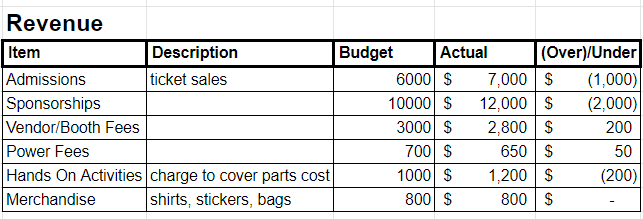Getting Started
It is important to start by defining the goal of the event. Is it to bring awareness to the organization? Is this an event that will cost the organization money? Is this going to be a break even event or a fundraising event? What is your overall event strategy? What are you planning to spend your money on in hosting this event? Good financial decisions require a budget that is both accurate and allows the organization to reach its goals for the event.
Next you should identify every part of your event that could potentially incur a cost. By splitting your event into chunks or parts, you will get a more accurate budget than just by looking at the bigger pieces. You can clarify and refine this as you work through the process and get quotes from vendors.
Spreadsheets or Budgeting System
If you are creating very complex budgets, you can look into budgeting software, but most events and organizations can do this in spreadsheets. Excel is a powerful tool, but Google Sheets work similarly and are easily shareable.
To build your own budget spreadsheet in Google Sheets, create a new worksheet with a few columns: Item, Description, Quantities Needed, Budgeted Cost, Actual Cost, Over/Under. Here are some examples:


Now add line items for every detail, even ones you believe will be donated. Donated products or services help keep your costs down, but it is important to know exactly what the event actually costs to hold. Therefore, you will need to track the value of any donated products or services.
Be very detailed - it is much easier to combine line items later than to separate them after the fact. Add expected expense amounts in and then you can fill in the actual costs later as they are incurred. The inclusion of an over/under column is so that anyone reviewing the budget vs. actuals can easily spot any potential issues or opportunities.
Do not forget to include line items for promotions, marketing, security, insurance, and technology needs (WiFi, A/V, Lighting, etc.). These things are essential to bringing an event to life but are often forgotten in the early stages of the planning process. You will be better prepared by having a plan in place for these intangible items from the beginning.
Getting the Data
If you are having some trouble getting started budgeting your costs, do some research. Look into similar events in your area. Nonprofit organizations are often willing to help each other out, so do not be afraid to ask for advice or help. If you are using your own prior year actuals to create your budget, make sure to account for inflation or market conditions that may impact current pricing.
Contact Potential Vendors
You can get pricing estimates from websites, email, making phone calls, or request a quote online. This step can take time, but is valuable if you want an accurate budget. Also consider offering vendors a sponsorship arrangement in exchange for donated or discounted goods or services. This will help with cash flow by keeping your costs down, but you should still keep track of your budgeted in-kind donations. You may not get these next year and will need to know the cost for future events.
IMPORTANT - Don’t always go with the cheapest option. Go with a vendor who understands your vision. These vendors are more likely to be potential sponsors and just might become long time community partners. Also, keep in mind that one expense can depend on another. For example, a particular venue may require you to use a specific electrician, caterer, internet, or A/V company.
Revenue
Event revenue is not just admissions. If you need to make sure to cover your costs and/or raise money for your organization, you can get really creative here. Consider alternative sources of revenue like sponsorships. In addition to any company you already have an operating relationship with, seek out anyone who you’ve noticed is supportive of community organizations like banks, orthodontists, realtors, and more. Ask your volunteers or team members to ask their employers or family member employers if they would be willing to sponsor your event - then you can create a fun and personalized sponsorship package for them.
Another option for revenue is selling swag or merchandise. If you choose this route, make sure you understand sales tax and unrelated business income tax requirements in your area (nonprofits are NOT exempt from unrelated business income taxes). Also keep in mind that you will need to incur the costs of whatever you want to sell, so keep it exclusive and only order what you know you can sell. You don’t want to get stuck with inventory on hand and the lost revenue of being unable to sell it.
Other Things to Consider
Keep close track of deadlines. Things often get more expensive as time or key dates pass by. Do not underprice anything just to make it look good on paper. Be realistic - a good rule of thumb in budgeting is to be aggressive with your expense budget and conservative with your revenue budget. Remember that cheapest is not always the best option. Sometimes, spending a little extra in a certain area can make the difference between a good event and an amazing one (decorations, signage, lighting, etc.).
Most importantly, make sure you communicate regularly with your team. It is critical to make sure that everyone is on the same page at regular intervals so you can all support each other and have an amazing and successful event!